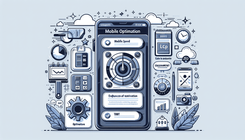How to Improve Mobile Speed for My Dawn Optimized Website
Hello Shopify merchants,
If you have tested your website speed and found that it performs poorly on mobile devices, you're not alone. Mobile optimization is crucial for user experience and can significantly impact your online store's performance. Let's dive into an actionable guide to improve your Dawn optimized website's mobile speed.
Identifying the Problem
Upon reviewing your site, we often find issues related to the Largest Contentful Paint (LCP) and Total Blocking Time (TBT). When focusing on the mobile version of your product page, these issues become more pronounced.
What Are LCP and TBT?
- Largest Contentful Paint (LCP): This metric measures how long it takes for the largest content element in the viewport to become visible. Ideally, this should happen within 2.5 seconds for good performance.
- Total Blocking Time (TBT): This metric quantifies the total amount of time your site is blocked from responding to user input. It should be less than 300 milliseconds to ensure a smooth user experience.
Common Causes of Slow Mobile Speed
- Unoptimized Images: Large image files can slow down your page load time significantly.
- Excessive JavaScript: Heavy JavaScript files can block the rendering of your webpage, leading to delays.
- Unnecessary Code: Extra code, such as unused styles and scripts, can bloat your website's loading time.
- Too Many HTTP Requests: Multiple HTTP requests for scripts, stylesheets, and images can delay the initial load time.
- Render-Blocking Resources: CSS and JavaScript that block the browser from rendering the page can cause delays.
- Excessive Liquid Loops: Overuse of Liquid loops in Shopify templates can slow down performance.
Step-by-Step Guide to Improve Mobile Speed
1. Remove Unnecessary Code
Unnecessary code can bloat your website and slow down load times. Conduct a thorough code review to identify and remove any unused styles, scripts, or settings.
How to Remove Unnecessary Code:
- Unused CSS: Identify and remove CSS styles that are not being used on your pages.
- Unused JavaScript: Remove scripts that don't contribute to the current page's functionality.
- Audit Installed Apps: Deactivate or remove apps that aren't adding significant value.
2. Optimize and Compress Images
Images play a significant role in how fast or slow your pages load. Optimizing them can drastically reduce load times.
How to Optimize Images:
- Compress Images: Use tools to compress your images without sacrificing quality.
- Lazy Loading: Implement lazy loading so images load only when they come into the user's viewport.
- Use Modern Formats: Convert images to modern formats like WebP for better compression rates.
3. Reduce JavaScript Execution Time
Heavy JavaScript can slow down your website by blocking the main thread.
How to Optimize JavaScript:
- Minimize Large Files: Break down large JavaScript files into smaller, manageable files.
- Asynchronous Loading: Load non-essential scripts asynchronously to avoid blocking the rendering process.
- Browser Caching: Store frequently-used JavaScript files locally on the user's device through caching.
4. Minimize Main-Thread Work
The main thread is responsible for rendering web pages. Minimizing its workload can enhance performance.
How to Reduce Main-Thread Work:
- Defer Non-Essential Scripts: Use the defer attribute to delay non-essential scripts until the HTML is fully parsed.
- Optimize CSS Delivery: Reduce render-blocking CSS by inlining critical above-the-fold styles.
- Prioritize Critical Rendering Path: Ensure the critical rendering path is optimized by loading only essential resources first.
5. Beware of Excessive Liquid Loops
Liquid loops in Shopify can iterate over items multiple times, leading to performance issues.
How to Identify and Optimize Liquid Loops:
- Review Custom Code: Check for custom sections, snippets, or apps that involve dynamic content and loops.
- Use Developer Tools: Utilize Shopify theme inspector or browser developer tools to analyze Liquid code.
- Optimize Queries: Streamline your Liquid loops and queries for efficiency.
6. Reduce Web Page Size
Long web pages can take longer to load, especially on mobile devices.
How to Reduce Page Length:
- Concise Content: Minimize unnecessary content and elements on your page.
- Pagination: Implement pagination for long product lists or blog posts.
- Optimize Fonts: Use a limited number of font styles and weights to reduce load times.
Questions and Answers
Q: How can I test my website speed effectively?
A: Use tools like Google PageSpeed Insights to get a detailed report on your website's performance. Focus on both mobile and desktop reports to identify areas for improvement.
Q: What is 'lazy loading,' and how does it help?
A: Lazy loading is a technique where images and other media elements are loaded only when they are about to enter the viewport. This reduces initial load time and saves bandwidth, thereby improving page speed.
Conclusion
Improving the mobile speed of your Dawn optimized website is essential for providing a better user experience and improving your conversion rates. By following the steps outlined above, you can significantly enhance your site's performance. Remember to test your changes incrementally and keep backups of your theme to avoid any disruptions.
If you have any additional questions or need further assistance, feel free to reach out. Happy optimizing!




